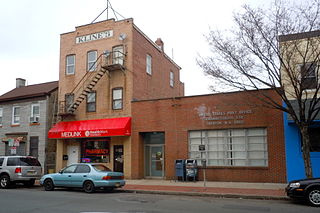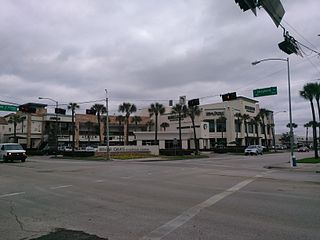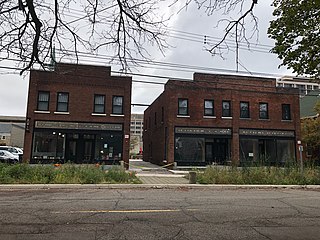
A supermarket is a self-service shop offering a wide variety of food, beverages and household products, organized into sections. This kind of store is larger and has a wider selection than earlier grocery stores, but is smaller and more limited in the range of merchandise than a hypermarket or big-box market. In everyday United States usage, however, "grocery store" is often used to mean "supermarket".
S. H. Kress & Co. was the trading name of a chain of five and dime retail department stores in the United States established by Samuel Henry Kress. It operated from 1896 to 1981. In the first half of the 20th century, there were Kress stores with ornamented architecture in hundreds of cities and towns.

Chambersburg is a neighborhood located within the city of Trenton in Mercer County, in the U.S. state of New Jersey. It is considered part of South Trenton. Chambersburg was an independent municipality from 1872 to 1888.
Gifford Park is a historic neighborhood in midtown Omaha, Nebraska. It is roughly bounded by the North Freeway on the east, North 38th Street on the west, Dodge Street on the south and Cuming Street on the north. Its namesake park was added to the City parks network in 1916. The neighborhood is bounded by several historic neighborhoods, including Bemis Park, Gold Coast, and the Near North Side.

The Main Street Historic District in Fort Atkinson, Wisconsin, United States, was placed on the National Register of Historic Places in 1984. The district is composed of 51 buildings on or within a block of Main Street.

Feraud General Merchandise Store, also known as 1903 Building, was built in 1903 in Ventura, California. Jules Feraud opened the Feraud Bakery and Grocery Store and the bakery stayed in the family until 1944. The brick building is a rare intact example of turn-of-the-century commercial architecture during Second Land Boom after the tracks of the Southern Pacific Railroad arrived in Ventura. The City Council of Ventura designated the building Historic Landmark Number 35 by resolution on July 17, 1978. The building was listed on the National Register of Historic Places in 1986.

The Belmont Hotel is a twelve-story residential high rise built as a hotel on the Capitol Square in Madison, Wisconsin, in 1924. At that time it was the tallest building near the Capitol, and concern that it blocked the view spurred height-limit restrictions that are still in place. In 1990 the building was placed on the National Register of Historic Places.

O Street Market, also known as Northern Market, is a historic structure located at 1400 7th Street NW in the Shaw neighborhood of Washington, D.C. Built in 1881, it is one of three 19th-century public market buildings still standing in the city, along with Eastern Market and Georgetown Market. The market was listed on the District of Columbia Inventory of Historic Sites in 1968 and the National Register of Historic Places in 1995. The most distinctive architectural element of the Gothic Revival building is its corner tower on 7th and O Streets.

The Senator Hotel (1924–1979) was a nine-story, 400-room Italian Renaissance-style hotel in Sacramento, California located at 12th and L streets across from the California State Capitol building that served as a nexus of California political and social activity for more than 50 years. Opened in 1924, the Senator Hotel was where Arthur Samish, one of the most influential and powerful individual lobbyists in the history of California, maintained a suite during the 1930s and 1940s. President Gerald Ford spent the night at the Senator Hotel before the September 5, 1975, assassination attempt on him by cultist Manson family disciple Squeaky Fromme. Although the Senator Hotel was listed on the National Register of Historic Places in May 1979, the hotel was closed two months later and shuttered with panels placed over the windows that same year. The structure was renovated and then reopened in 1983 as an office building under the name Senator Hotel Office Building, giving lobbyists short-walking-distance access to California's state politicians.

The B and C Grocery Building is a commercial building located at 417-19 South Main Street in Royal Oak, Michigan. It was listed on the National Register of Historic Places in 2006.

The Cranston–Geary House also known locally as the Bramson Home is a historic home listed on the National Register of Historic Places. The house is a Craftsman-style home designed by George Sellon, California's first state architect.

The Iron Mountain Central Historic District is a historic district, broadly located between Fleshiem and C Streets and between Iron Mountain and Stockbridge Avenues in Iron Mountain, Michigan. The district covers the city's central business district and adjacent areas. It is primarily commercial, but also contains the historic county courthouse complex, and school, library, and church buildings. It was listed on the National Register of Historic Places in 2013.
Howard Avenue is a north-south road in the West Tampa and South Tampa sections of Tampa, Florida. South Howard is home to the SoHo (Tampa) entertainment district and several popular restaurants and bars. North Howard is home to several historic buildings.

The River Oaks Shopping Center is a shopping center in Neartown, Houston, adjacent to River Oaks. As of 2012 the more than 322,000-square-foot (29,900 m2) center includes one grocery store, one movie theater, 14 restaurants, and 76 stores. The center, owned by Weingarten Realty, is the third oldest shopping center of its type in the United States.

Hotel Charitone is a historic building located in Chariton, Iowa, United States. Local architect William L. Perkins designed the building in the Neoclassical style. It was his second major commission in town after the Chariton Herald-Patriot Building (1918). Local contractor P.E. Johnson constructed the building. It opened on November 5, 1923, and remained in operation as a hotel with some apartments under various owners. The buildings had fallen into disrepair and was vacant when Hy-Vee, a grocery store chain that had been headquartered in Chariton for years spearheaded the renovation of the building as an act of gratitude for the community's support.

The Simeon Mills Historic District is a group of seven historic commercial buildings two blocks west of the capitol square in Madison, Wisconsin, constructed from around 1845 to 1887. In 1987 the district was added to the National Register of Historic Places - considered significant for its concentration of 19th century commercial buildings, which is unique in Madison.
George C. Sellon was the first state architect of California. He resigned as State Architect on May 1, 1909 after the legislature passed a resolution to prevent him from working on his own designs and from bringing in private commissions as State Architect. He went on to form a private architectural practice in Sacramento in 1909, which later became Lionakis.

The Bailey Buildings are two related commercial structures, located at 513-519 West Ionia Street in Lansing, Michigan. They were listed on the National Register of Historic Places in 2021.




















